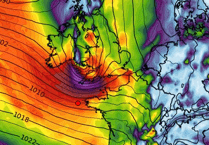I READ in one of the daily papers that the rules for the World Conker Fighting Championship say that all competitors wear goggles to protect their eyes.
Rules also require spectators to remain at least three metres away from the fights.
So different from when I played conkers at Landrake School, along with all the other pupils, girls as well as boys.
The playground was littered with broken conkers, or Horse Chestnuts, which is their proper name, and any casualties with bits of conkers in their eyes were always treated by the teachers.
It didn’t take long for all the trees in the parish to be stripped of their ‘fruits’ in the autumn and we would walk miles for them and all these conkers would be brought to the ground by throwing sticks up into the trees.
Of course, we also harvested Sweet Chestnuts, which were either eaten raw or brought home and roasted in the fire, and your hands got very black when you managed to get them out and peel them.
This is a good time to walk in the woods and look for mushrooms.
Perhaps the most colourful and poisonous ones are Fly Agarics that really make themselves seen with their red caps covered in circles of white spots.
These are tiny particles of a white veil that the mushroom pushes through as it rises to full height before spreading its cap.
Their common name comes from when the cap used to be broken into pieces and dropped into a saucer of milk.
This potion stupefied house flies that were attracted to it.
As I walked down through my favourite woodland path, I noticed something yellow on the low bank.
This was a clump of Calocera Viscosa, also known as Yellow Stags Horn, that looks like a tight bunch of tuning forks between two to three inches high.
This jelly fungus grows on dead, rotting wood and brightens up the vegetation.
At the end of the path I saw what I thought might be a brownish log lying in the long grass, but as I approached, the ‘log’ stood up on two legs and walked away.
Of course, it was a beautiful Cock Pheasant that I assumed must have been sleeping.
My method of walking slowly and quietly certainly paid off with this lovely sight.
Along the edge of the path were some Hogweed plants with fresh blooms on them, one of which was a cluster of pink flowers.
Odd really, as the flowers on most of the Hogweeds were turning into seeds but beside them, probably on the same roots, were new blooms which sometimes are pink in colour.
I saw a pile of cut tree trunks and went to look if there were any beetles living on them, but instead I was rewarded with the sight of a large Woodland Grasshopper. The Hawthorn trees are all loaded with red berries that are enjoyed by Blackbirds, Thrushes and visiting Fieldfares and Redwings. Many years ago I tried making wine with these numerous berries but it turned out to be a waste of time and sugar.




